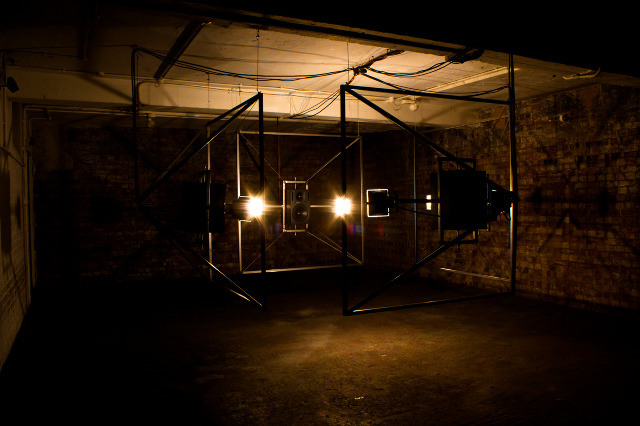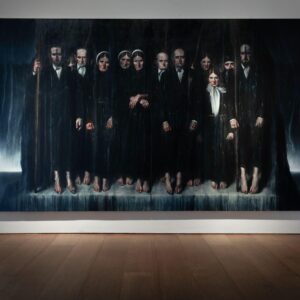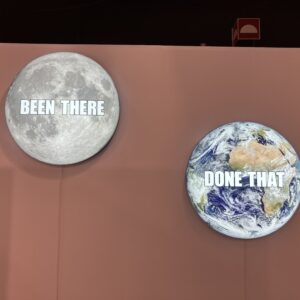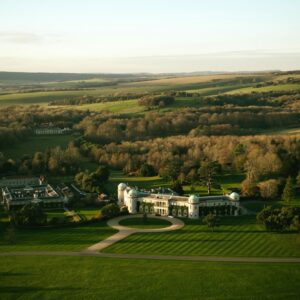
“I would not like to practice architecture at this moment,” says Sebastian Kite, who works with Will Laslett as the artist duo Kite & Laslett. “One day I would love to. At present, I want to continue to explore temporary forms of architecture and installations in our work. However, our projects exist on an architectural scale, they inhabit spaces.” Kite & Laslett did not decide to be artists; they became artists serendipitously, following one project to the next. “We’ve come into the art world from an architectural perspective. We are learning how the score of this realm works.”
The young architects-turned-artists do not practice architecture in the classical sense, but they did build their own home and workplace inside a derelict warehouse in East London. “Our personal lives and our practice very much revolve around the warehouse. This is where we had our first exhibition, our second, and then decided to build a home together with our friends.” The largest part of the warehouse is studio space that the artists use for producing and exhibiting large-scale projects. “The fact that we have a large studio allows us to make bigger work, therefore we think on a more architectural scale.”
Sebastian muses, “We sometimes get embarrassed when we say that we are installation artists because people misunderstand. They think we install art for someone else or that we install bathrooms… which we can do now!”
He compares the layout of the living space within the shell of the warehouse to a “neo-medieval maquette”: around the communal centre with the kitchen there are four individual pods on stilts made of scaffolding, or suspended from the warehouse’s original structural trusses.
Each of the friends designed their own pod according to their individual lifestyles. Sebastian’s pod is lit by a skylight that creates a framed view of an ever-changing skyscape above his desk, “inspired by the artist James Turrell.” The walls are made of textured plywood sourced from transportation crates. Sebastian points out, “We used mainly found materials from construction sites and rubbish tips.” Taking into account the high living costs and difficulty of London-based artists to afford large enough studios, their up-cycling of a derelict warehouse is an innovative solution for an adequate space to live and work. Whilst the studio is not in use for their own work it becomes a location for film, photography, music events and parties.
Sebastian comes from a creative family: his British father was a concert pianist and conductor, his German mother is a linguist and photographer. At 18, he made a choice between the study of music and architecture. “I chose to study architecture and thought that was a very mature and secure choice,” he reflects with a smile. It took him to Glasgow School of Art and later to Berlin. He found it hard to come back after a formative stay: “My horizon changed. In Berlin was the beginning of the idea that I’d like to make architecture as art, to produce temporary installations.”
Back in London where he had grown up, Sebastian completed the diploma at Westminster School of Architecture together with Will. “Now the primary thing is our artistic partnership”, he explains, “but we do other creative work to facilitate the projects that do not support themselves.” Sebastian values the detachment of not having trained as an artist and explains that architecture gave the duo the skills to realise projects on an architectural scale.
In hindsight, Sebastian really did not have to choose between architecture and music. “Our practice is very open to different media. Now I’m doing more music than ever.” Music or “sound experiments” are an important component of Kite & Laslett’s installations.
When Kite & Laslett realise a project, the process is characterised by exploration. In their recent quadraphonic sound and light installation Enclosure in an underground bunker-like space in Hoxton Gallery, there were welcome surprises: “some things we couldn’t control,” Sebastian Kite recalls.
“With the heavy base in one of the tracks I wrote for Enclosure, the lights turned themselves off because the frequency of the sound interfered with the electronics. So you experienced one of the pieces in the dark. The speakers were being forced so much that you actually felt a breeze. We’re interested in these incidentals that occur”
, affirms Sebastian.
“We’re not physics buffs with an ambition to predetermine all the technicalities. We’re far more driven by the phenomenological side and the emotional aspect of our work.” Visitors’ reactions to their experience-based installations are often revealing for the artists. “Enclosure turned into a party at the opening night. There was an amusing and surreal moment; I was packing up my equipment when a man who had lost his trousers came up to me asking in-depth questions about our work. I asked him what had happened to his trousers and he said he didn’t need them anymore. Later I found him stark naked at the centre of Enclosure, with his arms in the air, his body floating with the sound. Not in a homoerotic way, but it in primal sense, it was actually quite beautiful. He probably wanted to be liberated of his clothing because he was being warmed by the light and he could feel the sound moving through his body.”
Kite & Laslett’s next project will take them to Berlin, where the idea of working as an artist first evolved for Sebastian. The duo will create a site-specific installation and a sound piece for platform79–the berlin project, an exhibition of international contemporary art in a former women’s prison. “Upon our first encounter with the building, we pursued the procession of gated spaces leading to the main courtyard like the inmates would have,” recalls Sebastian.
“We were overwhelmed with the building’s height, scale and texture. The hard planes of red brick matched with the austere rhythm of the barred cell windows provided the inspiration for our piece. We are currently designing a form of panopticon for the base of the courtyard, a vantage point from which the viewer can observe an abstracted and constantly evolving image of the courtyard’s facade, peering into the cells.”
Words by Nora Isabelle Heidorn
Photographs (c) Sebastian Kite
More information about the artists on www.KiteandLaslett.com
More information about their upcoming exhibition in Berlin on www.platform79.com




